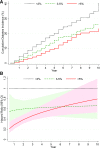Long-term Outcomes of Lifestyle Intervention to Prevent Diabetes in American Indian and Alaska Native Communities: The Special Diabetes Program for Indians Diabetes Prevention Program
- PMID: 29915128
- PMCID: PMC6014547
- DOI: 10.2337/dc17-2685
Long-term Outcomes of Lifestyle Intervention to Prevent Diabetes in American Indian and Alaska Native Communities: The Special Diabetes Program for Indians Diabetes Prevention Program
Abstract
Objective: Evidence for long-term translational effectiveness of lifestyle interventions in minority populations is scarce. This article reports long-term outcomes, for up to 10 years, of such an intervention to prevent diabetes in American Indian and Alaska Native (AI/AN) communities.
Research design and methods: From January 2006 to July 2016, the Special Diabetes Program for Indians Diabetes Prevention Program implemented the Diabetes Prevention Program lifestyle intervention among 46 AI/AN health care programs. Enrolled participants underwent a thorough clinical assessment at baseline, after completing the Lifestyle Balance Curriculum (postcurriculum assessment), and annually thereafter. Proportional hazards regression was used to estimate the association between diabetes incidence and postcurriculum weight loss status.
Results: Of 8,652 enrolled participants, 65% finished the postcurriculum assessment. The assessment completion rate diminished over time to 13% in year 10. Among those with postcurriculum weight measurements, 2,028 (36%) lost >5% of their initial weight, 978 (17%) lost 3-5%, whereas 2,604 (47%) had <3% weight loss (average weight loss 3.8%). Compared with those with <3% weight loss, participants with >5% weight loss had a 64% (95% CI 54-72) lower risk of developing diabetes during the first 6 years of follow-up, whereas those with 3-5% weight loss had 40% (95% CI 24-53) lower risk.
Conclusions: Moderate to small weight loss was associated with substantially reduced long-term risk of diabetes in diverse AI/AN communities. High participant attrition rates and nonoptimal postcurriculum weight loss are important challenges found in this translational effort implemented in an underserved population.
© 2018 by the American Diabetes Association.
Figures



Similar articles
-
Advancing Diabetes Prevention and Control in American Indians and Alaska Natives.Annu Rev Public Health. 2022 Apr 5;43:461-475. doi: 10.1146/annurev-publhealth-093019-010011. Annu Rev Public Health. 2022. PMID: 35380066 Free PMC article. Review.
-
Translating the Diabetes Prevention Program into American Indian and Alaska Native communities: results from the Special Diabetes Program for Indians Diabetes Prevention demonstration project.Diabetes Care. 2013 Jul;36(7):2027-34. doi: 10.2337/dc12-1250. Epub 2012 Dec 28. Diabetes Care. 2013. PMID: 23275375 Free PMC article.
-
Regression to Normal Glucose Regulation in American Indians and Alaska Natives of a Diabetes Prevention Program.Diabetes Care. 2019 Jul;42(7):1209-1216. doi: 10.2337/dc18-1964. Epub 2019 Jun 8. Diabetes Care. 2019. PMID: 31177184 Free PMC article. Clinical Trial.
-
Psychosocial Predictors of Weight Loss among American Indian and Alaska Native Participants in a Diabetes Prevention Translational Project.J Diabetes Res. 2016;2016:1546939. doi: 10.1155/2016/1546939. Epub 2015 Nov 15. J Diabetes Res. 2016. PMID: 26649314 Free PMC article.
-
[Steps toward the primary prevention of type II diabetes mellitus. Various epidemiological considerations].Invest Clin. 1997 Mar;38(1):39-52. Invest Clin. 1997. PMID: 9235072 Review. Spanish.
Cited by
-
Investigation of the risk factors associated with prediabetes in normal-weight Qatari adults: a cross-sectional study.Sci Rep. 2024 Oct 4;14(1):23116. doi: 10.1038/s41598-024-73476-8. Sci Rep. 2024. PMID: 39367088 Free PMC article.
-
Increased Risk of Cardiometabolic Disease in Ideal Weight Adults With History of Overweight/Obesity in China: A Prospective Cohort Study.J Am Heart Assoc. 2024 May 7;13(9):e033610. doi: 10.1161/JAHA.123.033610. Epub 2024 May 3. J Am Heart Assoc. 2024. PMID: 38700033 Free PMC article.
-
Effectiveness of mDiabetes intervention in enhancing diabetes awareness and promoting healthy lifestyle changes among the general population in rural India.Front Public Health. 2025 Jan 29;12:1470615. doi: 10.3389/fpubh.2024.1470615. eCollection 2024. Front Public Health. 2025. PMID: 39944562 Free PMC article.
-
Advancing Diabetes Prevention and Control in American Indians and Alaska Natives.Annu Rev Public Health. 2022 Apr 5;43:461-475. doi: 10.1146/annurev-publhealth-093019-010011. Annu Rev Public Health. 2022. PMID: 35380066 Free PMC article. Review.
-
Assessing the feasibility and acceptability of Changing Health for the management of prediabetes: protocol for a pilot study of a digital behavioural intervention.Pilot Feasibility Stud. 2019 Nov 26;5:139. doi: 10.1186/s40814-019-0519-1. eCollection 2019. Pilot Feasibility Stud. 2019. PMID: 31788325 Free PMC article.
References
-
- U.S. Department of Health and Human Services Healthy People 2020: Improving the Health of Americans. Washington, DC, U.S. Government Printing Office, 2010
-
- U.S. Department of Health and Human Services, Centers for Disease Control and Prevention National Diabetes Statistics Report, 2017. Atlanta, GA, Centers for Disease Control and Prevention, 2017
-
- Pan XR, Li GW, Hu YH, et al. . Effects of diet and exercise in preventing NIDDM in people with impaired glucose tolerance. The Da Qing IGT and Diabetes Study. Diabetes Care 1997;20:537–544 - PubMed
-
- Tuomilehto J, Lindström J, Eriksson JG, et al. .; Finnish Diabetes Prevention Study Group . Prevention of type 2 diabetes mellitus by changes in lifestyle among subjects with impaired glucose tolerance. N Engl J Med 2001;344:1343–1350 - PubMed

